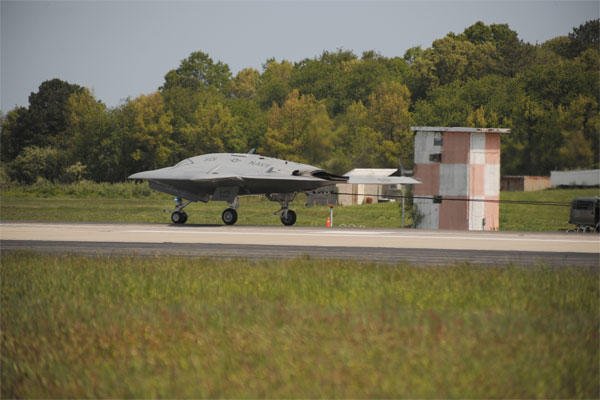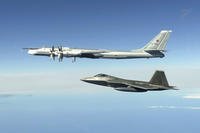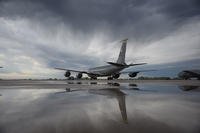U.S. military unmanned aircraft for the past decade have carried out reconnaissance and strike missions in "friendly," or permissive, skies.
The drone age began as the nation fought in lands without modem air defense systems, which could easily shoot down a slowmoving Predator.
Those days are winding down, and a new era of conflict with peer or near-peer competitors may be around the comer. So too are at least two new unmanned aircraft in development that could be stealthy enough to evade enemy radars, deliver payloads and glean intelligence behind enemy lines.
One is a top secret Air Force program, the RQ-180. The public knows littie about the aircraft other than what was revealed in an Aviation Week story published in 2013.
The Navy's unmanned carrier-launched airborne surveillance and strike (UCLASS) aircraft, still in the early stages of development, also has long-term requirements to carry out missions deep in an adversary's territory.
Whether it will ever be able to do so was a hotly debated subject at a recent House Armed Services Committee seapower and projection forces subcommittee hearing.
Several think tank analysts said the Navy was making a grave mistake by choosing endurance over range, payload and stealth.
A requirement that the UCLASS fly for 14 consecutive hours without refueling would mean more space devoted to fuel tanks and less to weapons, sensors and stealth.
What is at stake is the very future of aircraft carriers "for decades to come," said Robert Martinage, senior fellow at the Center for Strategic and Budgetary Assessments. "The Navy is aiming well off the mark."
Shawn Brimley, executive vice president and director of studies at the Center for a New American Security, said UCLASS "fails to add any real striking power to the carrier air wing." And it duplicates many of the intelligence, surveillance and reconnaissance platforms already available
China, the nation most often mentioned as a near-peer competitor by the analysts and committee members, has a goal of pushing U.S. aircraft carriers farther away from its shores. To do so, it is developing various anti-ship weapons.
"If we don't have a capability to project more than 1,000 nautical miles, we lose the ability to project power," Brimley testified.
Bryan McGrath, managing director of FerryBridge Group LLC, a defense consulting firm, took the seriousness of the issue one step further.
"I believe we have reached a 'For want of a nail, a kingdom is lost' moment," he said.
"If the air wing of the future does not evolve in a way that enables the kind of unmanned strike that a truly capable UCLASS would bring, the aircraft carrier might indeed become obsolescent. If that happens, the Navy will become far less powerful and influential. And that means a far less powerful and influential United States."
The reasoning behind the analysts' alarming statements is spelled out in Martinage's written testimony.
The requirement for 14 hours of unrefueled endurance will result in permanent design trades that will significantly reduce the aircraft's stealth, payload capacity and flexibility, he wrote. Those attributes are needed for the aircraft to be survivable in anti-access/areas denied scenarios.
"As a matter of physics, absent a breakthrough in engine technology, it is impossible to achieve 14 hours of unrefueled endurance with an aircraft sized to operate from an aircraft carrier without making changes to its shape and propulsion path that constrain passive radar signature reduction (i.e. stealth) potential and internal weapon carriage capacity," Martinage said.
One way stealth is achieved is by dampening an engine's heat signature. That requires structural designs that cannot be modified later, he said in an interview. Payload, endurance and survivability are always at odds If one is given more importance over the others, then there must be sacrifices. And a further complication for the UCLASS is that it must be sized correctly to operate off an aircraft carrier.
Brimley said China's so-called "carrierkiller," or the DF-21D anti-ship ballistic missile, which is designed to hit ships at ranges beyond the unrefueled range of a carrier strike group, is what may push carriers farther away from its shores.
"The primary way to keep the U.S. aircraft carrier relevant to future conflicts is to ensure that its embarked air wing has, in aggregate, sufficient stealth and strike power to penetrate adversary airspace and find and engage the full range of target types. ... We need the ability to operate stealthy strike aircraft at very long ranges from U.S. aircraft carriers," he said.
Brimley said unclassified specifications for the UCLASS denote a bias toward it being an ISR, rather than a strike platform.
Rep. Randy Forbes, R-Va., chairman of the subcommittee, clearly agreed with the analysts he had invited to testify.
"Unfortunately, in its current form, this committee has concluded that the UCLASS air systems segment requirements will not address the emerging anti-access/area denial challenges to U.S. power projection that originally motivated the creation of the ... program," he said.
A little more than a month after the hearing, the National Defense Panel, a congressionally appointed group that assesses the Defense Department's Quadrennial Defense Review, came down in favor of those who want the Navy to make the UCLASS a long-range strike system.
"We believe it is also critical to ensure that U.S. maritime power projection capabilities are buttressed by acquiring longer range strike capability again, manned or unmanned (but preferably stealthy) that can operate from U.S. aircraft carriers or other appropriate mobile maritime platforms to ensure precise, controllable and lethal strike with greater survivability against increasingly long range and precise anti-ship cruise and ballistic missiles," the report released July 31 said.
Defense Department and Navy officials at the hearing countered that there is a bigger picture than just the Navy's capabilities.
Air Force Brig. Gen. Joseph T. Guastella, deputy director of requirements for the Joint Chiefs of Staff and director of the joint requirements oversight council, said his organization had reviewed the UCLASS requirements six times, the latest in February.
The council must look at UCLASS in light of all of the services' assets, including space, he said.
"You cannot look at the UCLASS through a single lens," he said.
The Air Force's top secret new stealth aircraft, the RQ-180, was left out of the discussion during the hearing.
The analysts contended that if the 14 hours of endurance requirement remained, UCLASS would be a technological "dead end."
Military officials said the drone would be a spiral development with the ability to survive in contested environments, but not immediately.
"We don't know what the future requirements will be," said Vice Adm. Paul A. Grosklags, principal military deputy assistant secretary of the Navy for research, development and acquisition. "But we want to assure that this is not a dead end solution for the carrier force."
An aircraft with only eight hours of unrefueled endurance will he more costly to keep up in the air if tankers were required to replenish its fuel, he said.
"We are very comfortable with the unrefueled requirement as it sits and that it doesn't limit our ability to grow the objective requirements across the other balances of weapons, survivability, etcetera," he said.
He had seen preliminary designs produced by potential contractors and was satisfied that spiral development was possible, he said.
UCLASS must be a balance between cost, schedule and technical risk, said Mark Andress, assistant deputy chief of naval operations.
The initial requirements would be to defeat small boats in the littorals and coastal land-based threats, anti-surface warfare against near peers and to give or receive aerial refueling, he said.
"These scenarios, in which the co-coms intend to win and fight in the next decade, drove the right balance of endurance, sensors, weapons and self protection for UCLASS as a member of a carrier strike group," Andress said.
The need for more stealthy aircraft to penetrate deep inside enemy territory would not come to the mid-2020s, he added. That is also when the Air Force would also like to have a new long-range bomber, which may be optionally unmanned. Military strategists foresee a day when potential adversaries have much more capable anti-aircraft systems, including new radar technologies that could detect today's low-observable aircraft.
Grosklags said of UCLASS: "We are on a path to achieve this growth capability without sacrificing the affordable near-term persistent ISR capability."
As for survivability: "We know there are technical solutions out there that provide us the capability to grow to a more survivable, low observable platform if we decide to go down that path," he said.
He added: "I heard some earlier comments about an eight to 10 hour aircraft that could carry 4,000 pounds and could not be seen by anybody. Frankly, that doesn't exist ... it is not technically achievable today."
Martinage said in an interview if the 14-hour requirement were relaxed, there could be improvements to payload and survivability.
As for Grosklags' assertion that what the analysts are asking for doesn't exist, Martinage pointed to the X-47B, the experimental carrier based demonstration drone that is currently being tested.
"If you wanted to, you could take a similar design, the shape of that aircraft, scale it up a little bit, and quickly get to the eight hours endurance and 3,000 to 4,000 pounds of payload," he said.
The X-47B was designed for strike missions in anti-access environments, he pointed out.
Stealth is achieved two ways. One is the shape of the aircraft, and the other is the propulsion path, which reduces the engine signature by changing the path of the inlet. Efficiency is lost in the process, which means shorter endurance.
"You can't undo that later and decide you want to change the inlet and the exhaust because it would be a fundamental redesign of the aircraft," he said.
As for the RQ-180, Martinage declined to talk about the program.





























